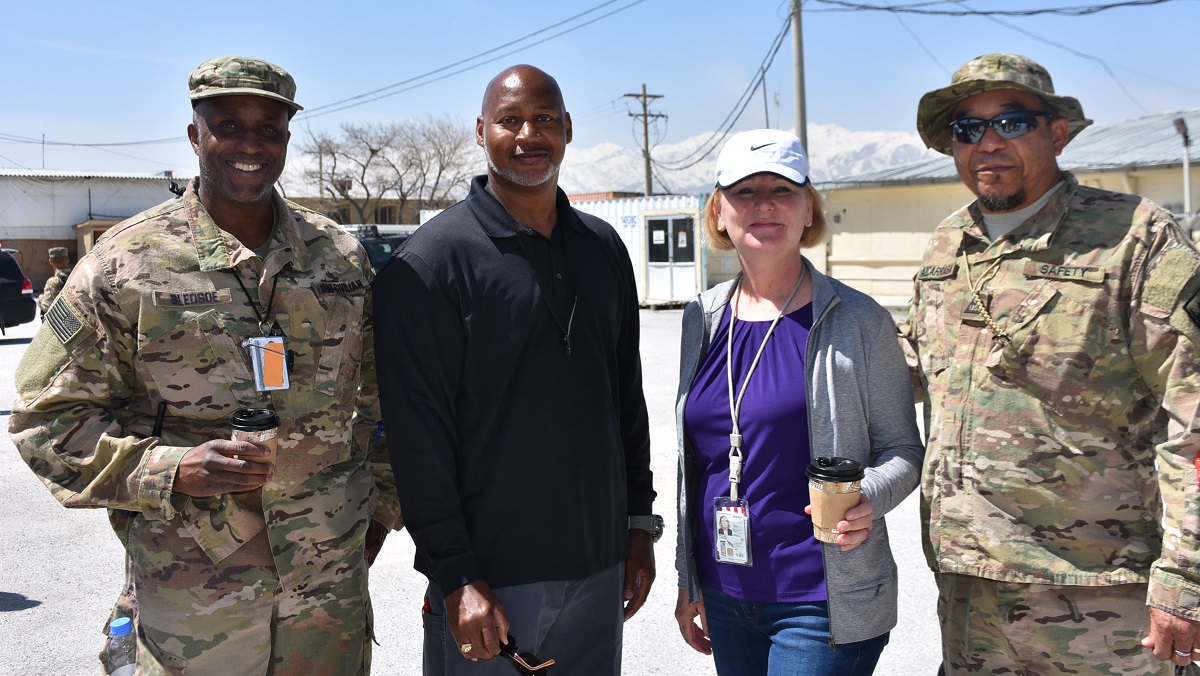
The AECW is an under-appreciated part of the workforce “always ready to answer the call.”
If the Army wants a culture of warfighting, team building and inclusivity of all its capabilities are essential. However, not all capabilities get the visibility that they should, due to the natural communication barriers that arise in large, complex organizations. The Army Expeditionary Civilian Workforce (AECW) is one such capability.
Modernizing the Army of 2030 and sustaining long-term readiness inevitably must include the civilian corps. Pondering the army profession, an unattributed author wrote:
The Army Civilian Corps has significantly broadened from providing administration support to conducting many of the Army’s operations within the generating force; and weighing the risk of death and bodily harm volunteering to stand alongside warfighters in the operational force where Army civilians joined the fight by supporting operations across a full spectrum of conflict.
The AECW is an under-appreciated part of the workforce “always ready to answer the call.”
Background and Evolution
In 2007, due to limitations with active and reserve military personnel dwell times, the Department of Defense (DoD) realized employing the civilian workforce was the best solution to alleviate strain on military force. The deployment of DoD civilians in contingency operations was influenced by three factors that were the driving force behind the concept of expeditionary civilians. The first factor was the initiation of the DoD’s insourcing initiative, aimed at reducing the services’ reliance on contractors. The second was a request in 2008 to staff positions in support of Iraqi ministries. The third factor was the demand from U.S. Central Command for civilian personnel through the Request for Forces (RFF) and Global Force Management (GFM) procedures. These processes presented an alternative that favored employing civilians for certain roles, reflecting a significant shift in how the DoD managed its’ workforce needs. In 2020, the Office of Secretary of Defense (OSD), Personnel and Readiness delegated AECW authority to Headquarters, Department of the Army (HQDA) G-1, Personnel Operations Group. HQDA G-1 oversees civilian readiness for training, deploying, redeploying, and reintegrating expeditionary civilians.
AECW’s capabilities—comprised of skills, adaptability, and expertise—increase the Army’s versatility in operating across multiple challenging and unpredictable environments. According to the HQDA G-1, the DoD deployed over 50,000 expeditionary civilians during the Iraq and Afghanistan wars. Presently, more than 1,000 civilians are supporting military forces across 20 countries. This force multiplier is an indispensable part of today’s military ecosystem, contributing to a resilient and versatile culture of warfighting that addresses complexities of the changing character of war, operations, and conflict resolution.
The AECW is a segment of permanent career appointment civilians who are specially trained and prepared to deploy alongside military units in support of national emergencies and global force management. Despite not being in uniform, members of the AECW are integral to the operational landscape, functioning within a variety of roles that demand resiliency and proficiency, whether technicians, engineers, medical professionals, or logistics specialists. Beyond immediate operational support, the AECW plays a foundational role in the stabilization and reconstruction of regions emerging from conflict. Development experts, economists, and governance specialists work to lay the groundwork for long-term peace and stability, addressing the root causes of conflict and helping communities recover and rebuild.
Operationally Ready with Strategic Importance
Bureaucracy and administrative burdens can slow decision-making and stifle the ability of units to adapt to new challenges. In numerous conversations with senior leaders, they have expressed to me the value of AECW civilians who bring skillsets not readily available among uniformed servicemembers; the presence of these expeditionary civilians in turn allows military personnel to dedicate their focus where it is most necessary—on core tactical and strategic missions. The integration of civilians within army and joint operations thus reflects a strategic approach to managing resources efficiently. Commanders must be aware of such resources and reach-back capabilities.
The AECW stands ready to offer strategic support to commanders facing challenges in imminent contested areas and global developments. Commanders can leverage AECW’s specialized skills, expansive knowledge, and adaptability, amid rapid technological developments. For instance, expeditionary civilians’ expertise in emerging technologies and cyber operations has enabled the Army to maintain a technological edge in warfare, ensuring communication security, effective cyber defense, and integrating advanced systems on the battlefield. Expeditionary civilian experience in civil-military operations is advantageous for navigating the complex social and political terrain of contested regions, facilitating engagement with local populations, and gathering intelligence.
This strategic integration creates a robust framework where civilians with high-tech skills in cyber operations can directly contribute to the Army’s cyber defense efforts.
The alignment between the AECW and the Army Cyber Excepted Service (ACES) represents a strategic integration of expertise aimed at strengthening national security in the digital age; both share the similar goals. ACES, designed to attract, recruit, and retain top-tier cybersecurity professionals, parallels the expeditionary workforce’s goals by emphasizing agility, technology proficiency, and the importance of specialized skills in addressing emergent threats. This strategic integration creates a robust framework where civilians with high-tech skills in cyber operations can directly contribute to the Army’s cyber defense efforts. By operating within ACES, members of the expeditionary workforce can leverage their unique abilities in cybersecurity to safeguard critical information systems, counteract cyber threats, and support the development and deployment of cyber capabilities.
Combatant Commands (CCMDs) and Army Service Component Commands (ASCCs) can submit support staff requirements for assignments ranging from 6–12-month rotations, not to exceed two years. Though the Under Secretary of Defense, Personnel and Readiness forecasts DoD expeditionary civilian demand signal and force pool, the process for requesting and gaining AECW deployment support is straightforward. CCMDs can submit a Joint Manning Document/ Request for Forces (RFF) through the Joint Staff. These requests are then validated and delegated to the service components or HQDA, G-1 to vet, recruit, and fill positions. Alternatively, ASCCs can work through HQDA G/3/5/7 and HQDA G-1 for requirements.
Challenges and Opportunities
The AECW is under-represented and under-utilized because military and civilian leaders are not aware of its’ benefits and opportunities. How can the Army further expand the reach and utility of AECW?
Invest in a forward-facing online presence for the AECW. Units should have ready access to information, including a sample joint manning requirements document, relevant policies, and the procedures for ASCCs to submit RFFs or central support requests. Publishing the requirements on a frequently visited Army.mil site will generate interest and further accentuate the program.
Promulgate knowledge through professional military education (PME). Schools at the intermediate, senior, and general officer levels can create awareness among future commanders and staff officers about the program’s options. PME curriculum developers should consider placing this AECW content within existing military readiness and force structure modules.
Revamp strategic human capital planning for the total force. As units conduct crisis and contingency planning, they should integrate AECW as a force enabler. In accord with the 2022 National Defense Strategy, the joint force must stretch resources in an ever changing threat landscape; better use of our civilian workforce should be one part of this.
Incorporation of the AECW offers an advantage for military commanders in the current and future landscapes of warfare. With their ability to adjust quickly to the dynamic nature of military operations, expeditionary civilians ensure their support remains relevant and responsive to commanders’ needs. The integration of AECW capabilities is indispensable for commanders as they leverage the full range of available expertise to confront emerging challenges in modern warfare and novel theaters of conflict.
Madeline Bodoh, PhD is a Department of the Army civilian. She is a graduate of the AY24 Resident Class of the U.S. Army War College and a member of the Carlisle Scholars Program.
The views expressed in this article are those of the author and do not necessarily reflect those of the U.S. Army War College, the U.S. Army, or the Department of Defense.
Photo Description: The Department of Defense Expeditionary Civilian program allows civilians to apply capability, experience and knowledge as a crucial part of helping DOD accomplish its mission abroad.
Photo Credit: DoD photo





Great article providing valuable information that addresses how commanders may enhance readiness with the Civilian Workforce as a Force Multiplier!
Interesting concept—and one that seems to blur the distinction between combatants and civilians, War and Non-War. One wonders what their legal status is on the battlefield. Is a AEC logistics advisor really any different from an Army logistics professional? Soldiers build hospitals too…
In the past, many cyber operators, “technicians, engineers, medical professionals, or logistics specialists” were roles filled by active-duty personnel—or, in the Middle East, military contractors. In some ways, this is not entirely a new idea. After all, civilians have always accompanied and supported warfighters across a variety of duties. These “civilians” don’t wear the uniform, but they are still integrated into the overall command structure (with danger pay). The high selection criteria also suggests that many will be veterans who have made the partial transition into management roles in Greater Washington DC. Some may become intelligence operators who “on core tactical and strategic missions” participate regularly in activities arguably termed “direct participation in hostilities” despite not being armed…
Thank you so much for this great contribution. Let us confirm here some key remarks and findings.
For every operation, let us try to evaluate the Total Net Benefits (TNB)), taking into account the Total Net Performances Generated (TNPG), the Total Values Gained (TVG), the Total Failures Observed (TFO), and the Total Risks Running (TRR). So, to sum up, we can write this logical equation:
TNB = TNPG + TVG – (TRR + TFO) or TNB = TNPG + TVG – TRR – TFO
These evaluations must be done ex-ante, in-itinere, and ex-post for all projects, programs, operations, actions, portfolios of programs-projects and operations, public policies and programs.
In my opinion, she has a major goal of “ inclusivity!” In my opinion, this is a misuse of priorities. As we saw withe attempted murder of former President Trump some of the women of the US Secret Service were not capable of performing as “Meat Shields” which is their job! They were too short to provide a complete “Meat Shield!” Also, from the video of the crisis they appeared confused on what action to take. One US Secret Service agent, a woman, was unable to holster her pistol.
When deputized, armed federal law enforcement officers fly commercial airplanes they are required to assist the air marshals. The female law enforcement officers seek to be excluded since they are too weak to physically restrain a passenger, their only option is to shoot which is a danger to the whole aircraft because of the potential for explosive decompression!
In my opinion, merit and ability to do the job should override “ inclusivity” every time. In the book, Radical Uncertainty, there is a time to use probabilities and other times it is a mistake to think in terms of probability.
We see an utter failure of the Department of State to provide the cultural knowledge and a knowledge of a nation to help formulate plans with incomplete knowledge.
As we see with the Israel vs Hamas war, what is required to formulate a path to victory? How do we transform battlefield success into a political victory?